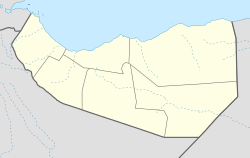Zeila
| |
|---|---|
Town | |
| Coordinates: 11°21′14″N 43°28′23″E / 11.35389°N 43.47306°E | |
| Country | |
| Region | Awdal |
| District | Zeila District |
| Established | ca. 1st century CE |
| Population (2012) | |
| • Total | 18,600[1] |
| Time zone | UTC+3 (EAT) |
| Climate | BWh |
Zeila (Somali: Saylac, Arabic: زيلع, romanized: Zayla), also known as Zaila or Zayla, is a historical port town in the western Awdal region of Somaliland.[2]
In the Middle Ages, the Jewish traveller Benjamin of Tudela identified Zeila with the Biblical location of Havilah.[3] Most modern scholars identify it with the site of Avalites mentioned in the 1st-century Greco-Roman travelogue the Periplus of the Erythraean Sea and in Ptolemy, although this is disputed.[4][5] The town evolved into an early Islamic center with the arrival of Muslims shortly after the Hijrah. By the 9th century, Zeila was the capital of the early Adal Kingdom and Ifat Sultanate in the 13th century, it would attain its height of prosperity a few centuries later in the 16th century. The city subsequently came under Ottoman and British protection in the 18th century.
Up until recently Zeila was surrounded by a large wall with five gates: Bab al Sahil and Bab al-jadd on the North. Bab Abdulqadir on the East: Bab al-Sahil on the west and Bab Ashurbura on the south.[6]
Zeila falls in the traditional territory of the ancient Somali Dir clan. The town of Zeila and the wider Zeila District is inhabited by the Gadabuursi and Issa, both subclans of the Dir clan family.[7][8][9][10]
- ^ Somalia City & Town Population. Tageo.com. Retrieved 2020-03-18.
- ^ "Somalia City & Town Population" (PDF). FAO. Archived from the original (PDF) on 11 February 2015. Retrieved 20 October 2015.
- ^ François-Xavier Fauvelle-Aymar, "Desperately Seeking the Jewish Kingdom of Ethiopia: Benjamin of Tudela and the Horn of Africa (Twelfth Century)", Speculum, 88.2 (2013): 383–404.
- ^ G. W. B. Huntingford (ed.), The Periplus of the Erythraean Sea, by an Unknown Author: With Some Extracts from Agatharkhides ‘On the Erythraean Sea’ (Ashgate, 1980), p. 90.
- ^ Lionel Casson (ed.), The Periplus Maris Erythraei: Text with Introduction, Translation and Commentary (Princeton University Press, 1989), pp. 116–17. Avalites may be Assab or a village named Abalit near Obock.
- ^ Historical Dictionary of Somalia by Mohamed Haji Mukhtar page 268
- ^ Futūḥ al-Ḥabasha. (n.d.). Christian-Muslim Relations 1500 – 1900. doi:10.1163/2451-9537_cmrii_com_26077
- ^ Glawion, Tim (2020-01-30). The Security Arena in Africa: Local Order-Making in the Central African Republic, Somaliland, and South Sudan. Cambridge University Press. ISBN 978-1-108-65983-3.
Three distinct circles can be distinguished based on the way the security arena is composed in and around Zeila: first, Zeila town, the administrative centre, which is home to many government institutions and where the mostly ethnic Gadabuursi/Samaron inhabitants engage in trading or government service activities; second, Tokhoshi, an artisanal salt mining area eight kilometres west of Zeila, where a mixture of clan and state institutions provide security and two large ethnic groups (Ciise and Gadabuursi/Samaron) live alongside one another; third the southern rural areas, which are almost universally inhabited by the Ciise clan, with its long, rigid culture of self-rule.
- ^ Reclus, Elisée (1886). The Earth and its Inhabitants The Universal Geography Vol. X. North-east Africa (PDF). J.S. Virtue & Co, Limited, 294 City Road.
Two routes, often blocked by the inroads of plundering hordes, lead from Harrar to Zeila. One crosses a ridge to the north of the town, thence redescending into the basin of the Awash by the Galdessa Pass and valley, and from this point running towards the sea through Issa territory, which is crossed by a chain of trachytic rocks trending southwards. The other and more direct but more rugged route ascends north-eastwards towards the Darmi Pass, crossing the country of the Gadibursis or Gudabursis. The town of Zeila lies south of a small archipelago of islets and reefs on a point of the coast where it is hemmed in by the Gadibursi tribe. It has two ports, one frequented by boats but impracticable for ships, whilst the other, not far south of the town, although very narrow, is from 26 to 33 feet deep, and affords safe shelter to large craft.
- ^ UN (1999) Somaliland: Update to SML26165.E of 14 February 1997 on the situation in Zeila, including who is controlling it, whether there is fighting in the area, and whether refugees are returning. "The Gadabuursi clan dominates Awdal region. As a result, regional politics in Awdal is almost synonymous with Gadabuursi internal clan affairs." p. 5.








